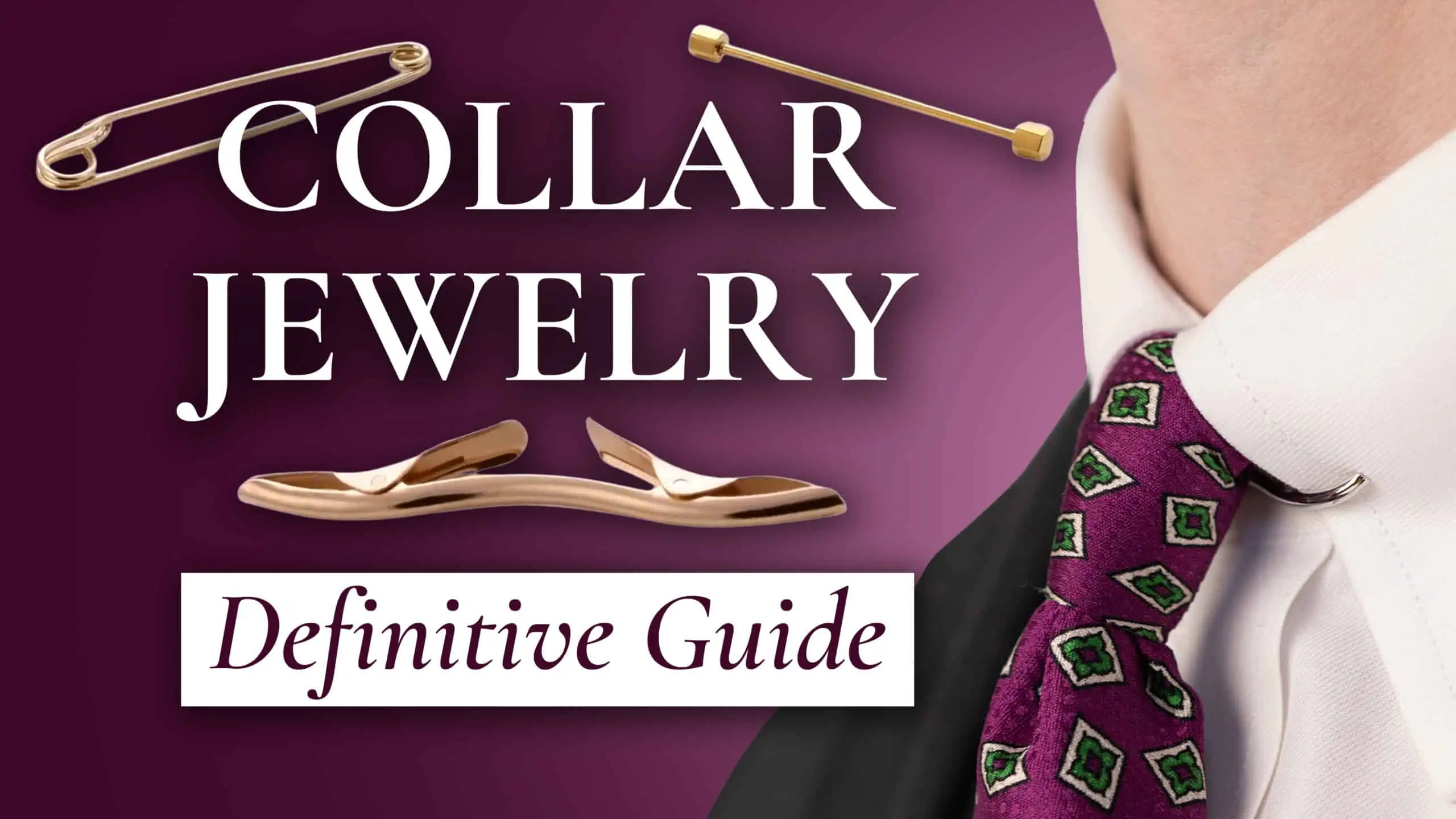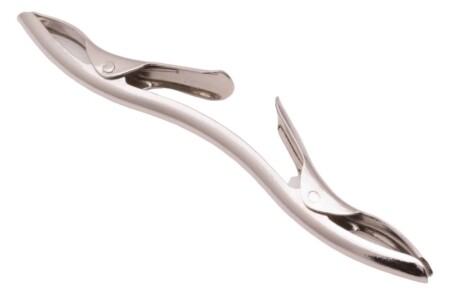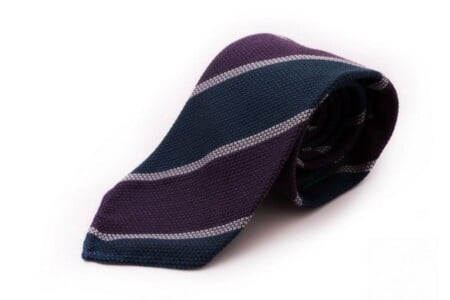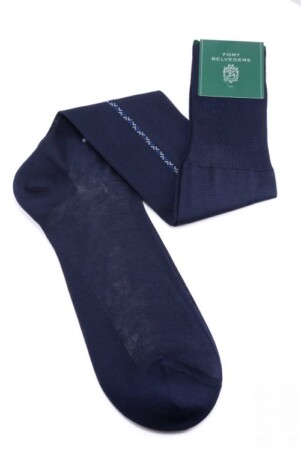Today’s installment of our “Definitive Guide” series pertains to collar jewelry, which we’re defining as any jewelry worn on the collar of a dress shirt as part of classic men’s style. Therefore, what we won’t be discussing today are types of jewelry from other menswear sub-genres like modern collar studs or casual chains.
In addition to covering the most conventional types of collar jewelry, you’ll see today, those being collar pins, bars, and clips, we will also go over a couple of more historical styles. So, we’ll look at the general history of collared jewelry, how it impacts menswear today, and how you can incorporate it into your own looks. With a nod to jazz great and jive slang aficionado, Cab Callaway, get ready to “collar” all that we have to say about collar jewelry.
A (Brief) History of Collar Jewelry
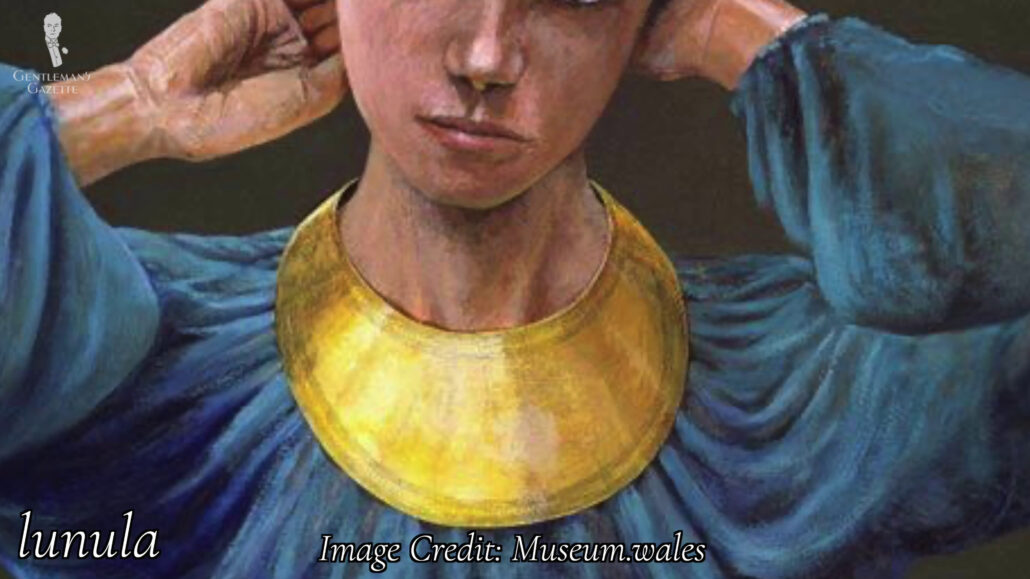
Throughout history, mankind has had a fascination with wearing jewelry around the neck – from the Ancient Egyptian Usekh and the Celtic lunula, to medieval and early modern bejeweled collars and decorative gorget. The last of these, by the way, was originally a decorative piece of armor protecting the throat.
Collar Jewelry: Starched Collars
1. Collar Studs
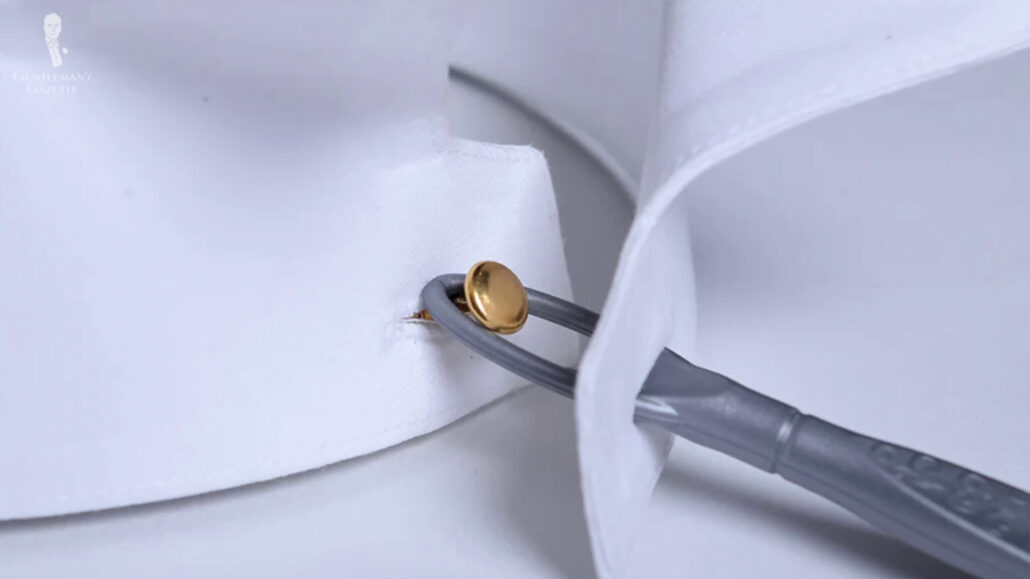
There are many more examples that we could list here, but for the sake of brevity and to keep things relevant to the majority of what we’ll be discussing today, we’ll fast forward to the mid-19th century and the types of collar jewelry worn with starched collars. More specifically then, we’ll begin in earnest by discussing the classic collar stud.
This functional piece of jewelry, which you might recognize from television shows like Downton Abbey or Peaky Blinders, was used to hold in place the detachable starched collars that men wore with their dress shirts in the 19th century.
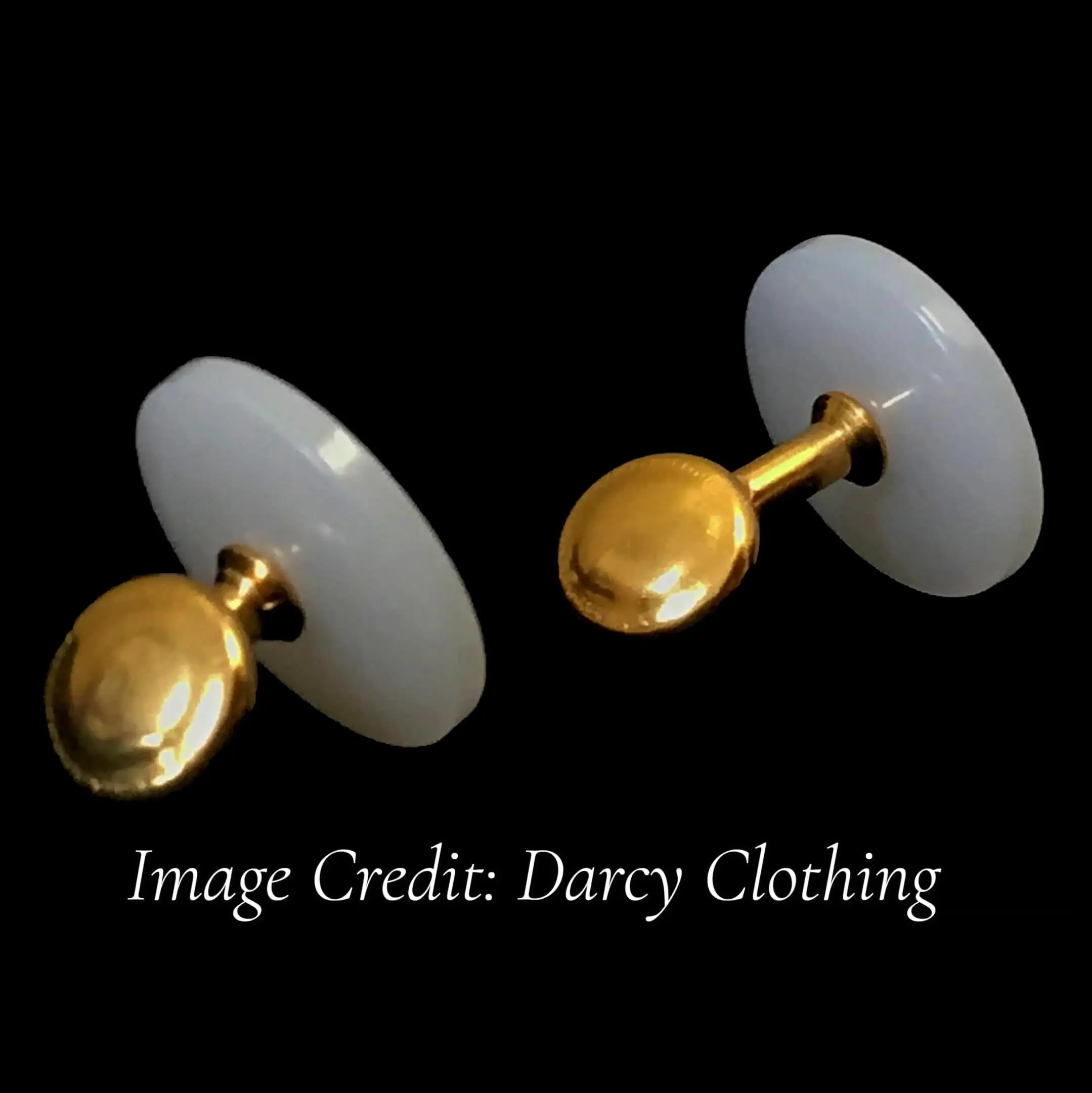
The basic stud was one piece consisting of a simple shaft with a flat head and flat back. Some designs, however, had improved functionality with things like swiveling heads or pole-pin mechanisms to make them easier to put on and take off.
Designs could be fairly simple, like ball or oval studs, or heavily ornamented with ornate designs. Mass market examples were typically made from brass, but formal, luxurious color studs were also made from things like precious metals, such as gold and silver, and using precious or semi-precious stones. The British Royal Air Force even produced studs with hidden compasses in them.
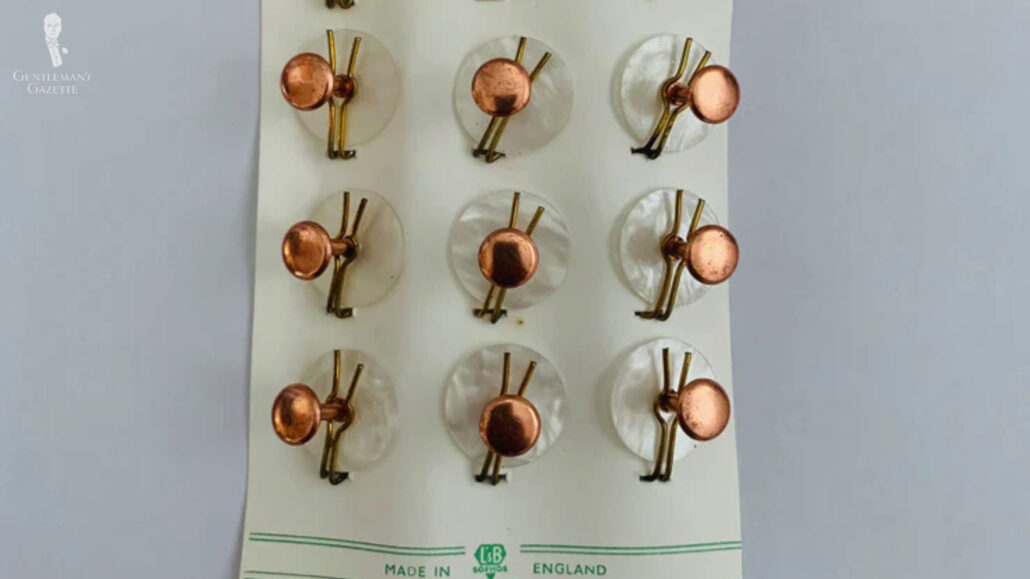
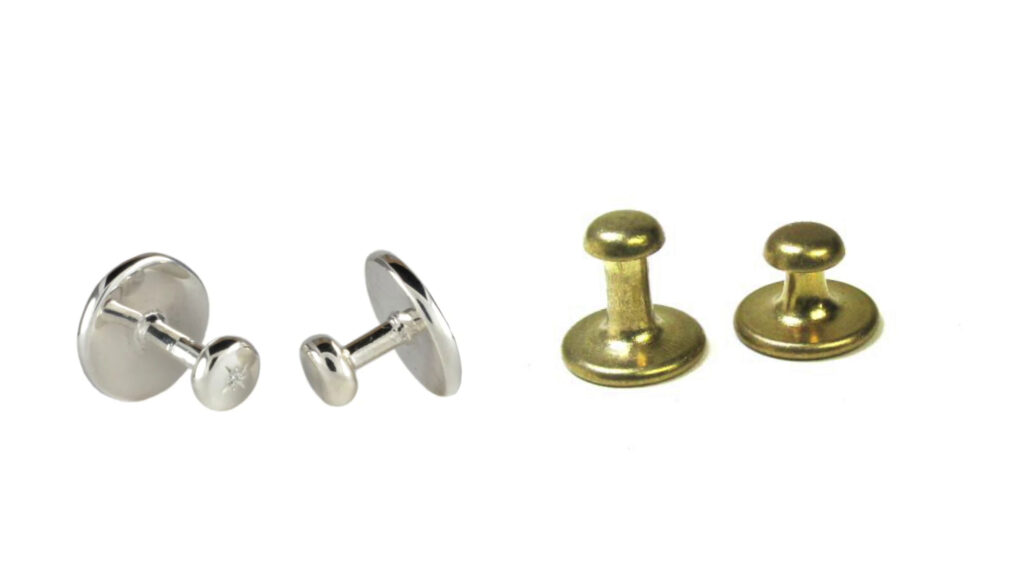
2. Tie Retainers
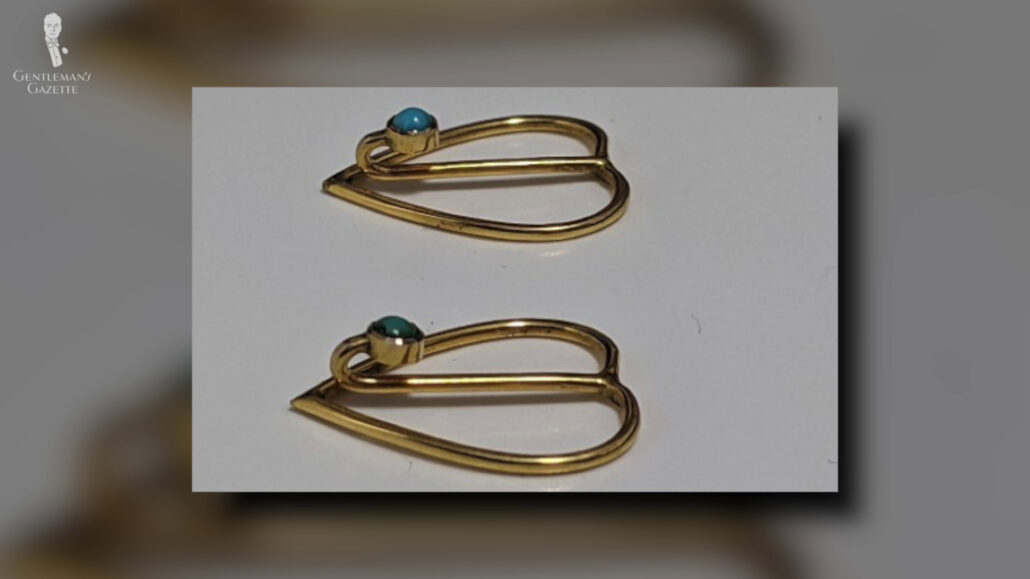
With that, we can find our way to the next type of color jewelry worn with starch collars: the tie retainer. Neckwear could often ride up the smooth, glossy sides of a starched collar. So, to hold their neckwear in place, men use different types of tie retention systems, like the tie retainer, which was, in essence, an early form of tie clip.
In the example you’re seeing here, the heart-shaped piece would be inserted behind the collar, upside-down, so that the shaft and crook could sit in front of the collar and hold the tie fabric in place.
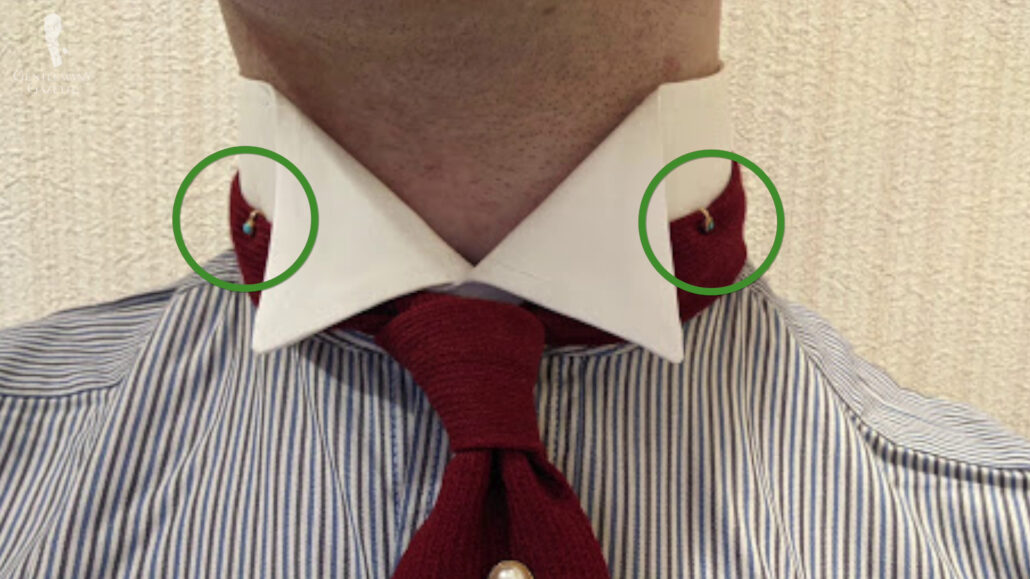
The visible portion of the clip was decorated because, after all, if people were going to see it, it might as well look nice. By the way, if these two examples have piqued your interest, then we think you’ll enjoy our guide on obscure men’s jewelry.
They Wore What?! 10 Obscure Men’s Accessories & Jewelry
The Transition from Starched Collars to Soft Collars
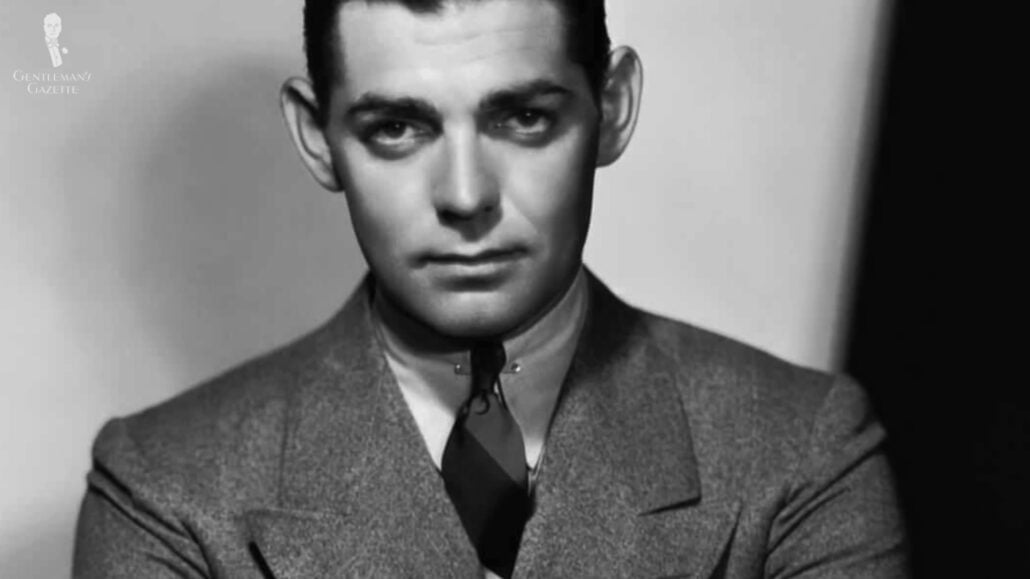
Around the 1910s, most men were switching from wearing stiff, starched collars most of the time to softer, attached collars. So, what happened here? Well, men needed new types of collar jewelry.
The biggest issue with soft collars is that the collar tips – technically called “leaves” – could become droopy and disjointed in an asymmetric or sloppy fashion. During the Golden Age of Menswear, though, most men preferred their collars to be neat and structured with a tight distance between the two collar leaves called a “collar spread.
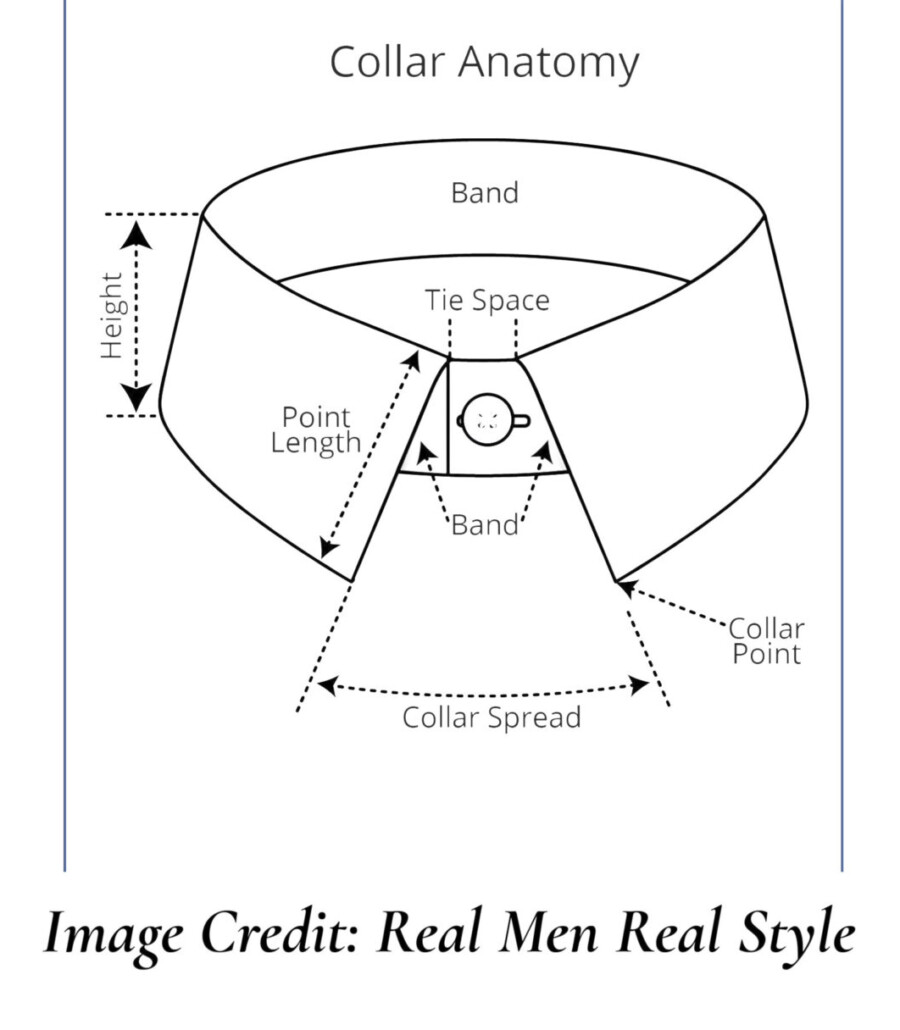
Because collars were no longer regularly starched then, new types of collared jewelry were needed to give the collar structure, hold the leaves tightly together, and elevate the tie knot. There’s a good chance you’ve heard of the latter three types of collar jewelry we’re going to discuss today, but first, we’ll start with two more obscure examples.
Soft Collars
3. Collar Tips
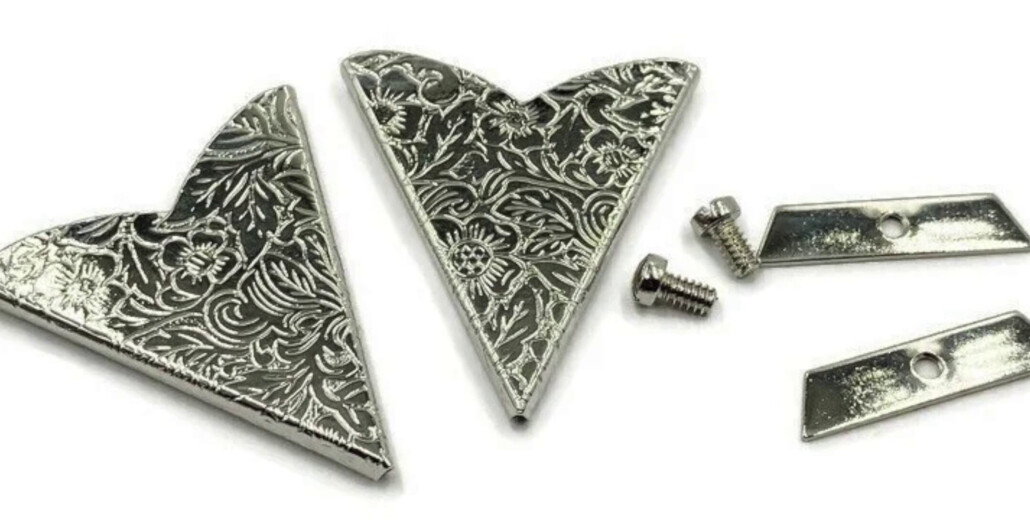
The first of these would be collar tips, which are occasionally worn in classic menswear as a way to give the collar some adornment when not wearing a tie. This accessory came to prominence in the 1940s when America was in the grips of a cowboy craze. In addition to creating some unexpected visual interest, the tips also weighed down the leaves of the collar, holding them in place as a sort of reverse collar stay.
Speaking of collar stays, by the way, we won’t be discussing them at length today because, unlike collar tips, collar stays, when worn properly, are not visible. Therefore, they are purely functional and don’t really serve as jewelry. Besides, we’ve already made a guide about collar stays.
Shirt Stays & Collar Stays Guide
Should You Wear Collar Tips Today?
As to the question of whether you should wear collar tips today, we wouldn’t really recommend it if you’re going for a standard, classic look, even though they do have some historical pedigree. If you’re going for a distinctly Western outfit or looking to stand out in a unique way, then collar tips might be for you, but generally, we’d advise against them.
4. Collar Brooches
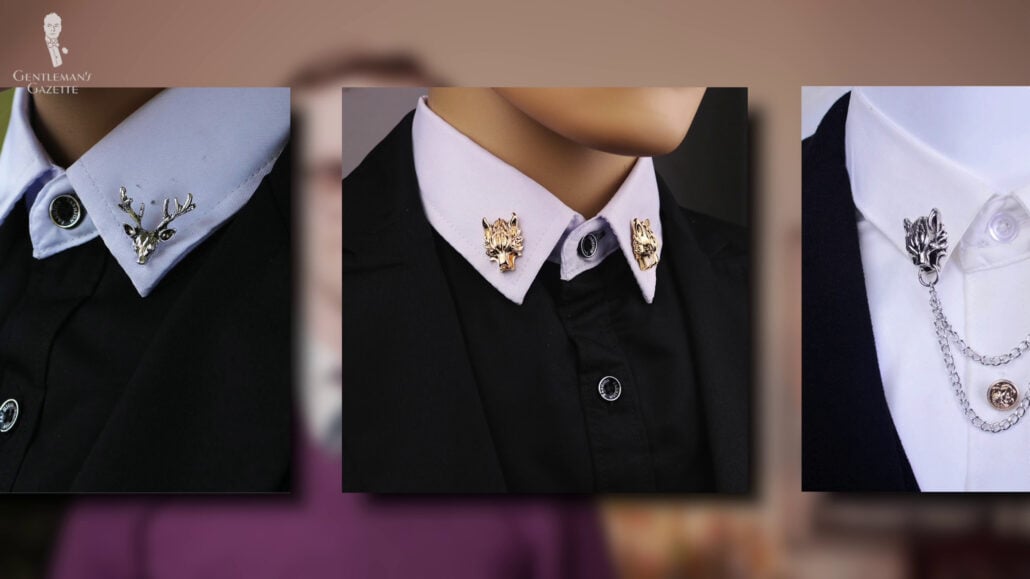
Next up is an even more “exuberant” piece of collar jewelry: the collar broach. Collar brooches are worn either attached to the collar leaves with pins or using the pinhole collar or worn in the collar spread in lieu of a tie.
They usually feature bold, decorative elements that like collar tips can be pretty audacious and might come off as showy or affected. And, again, if what you’re going for is a classic look, then we’d advise against them. If you do want to be more avant-garde, though, go ahead and broach the subject.
5. Collar Pins
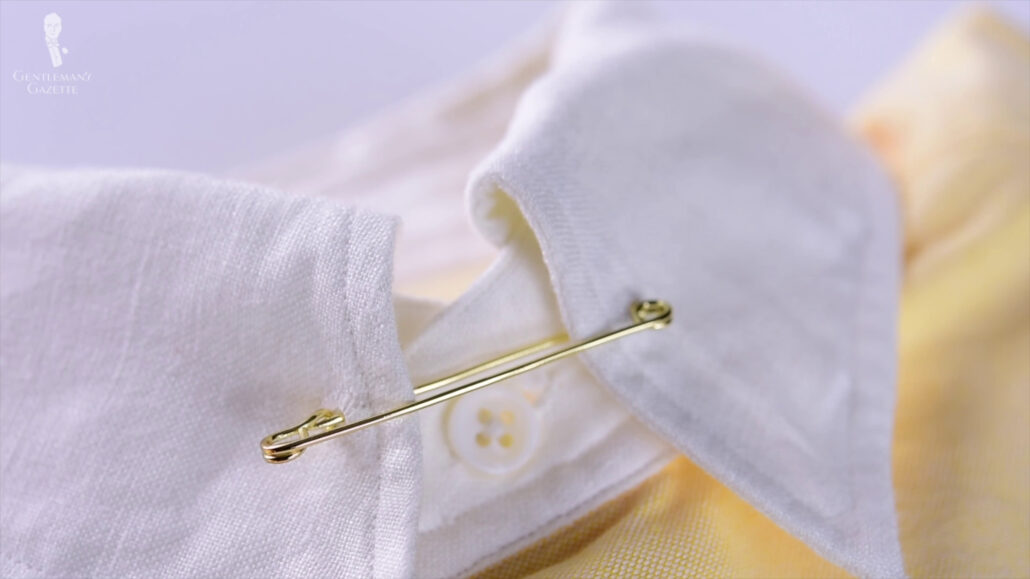
From here on out, we’ll be discussing the three most commonly worn types of collar jewelry, both historically and today, starting with collar pins.
As the name implies, this accessory consists of a pin that pierces both of the collar leaves, holding them in place. This retains the leaves in a level position to one another, holds them closer together for a tighter collar spread, and elevates the tie knot.
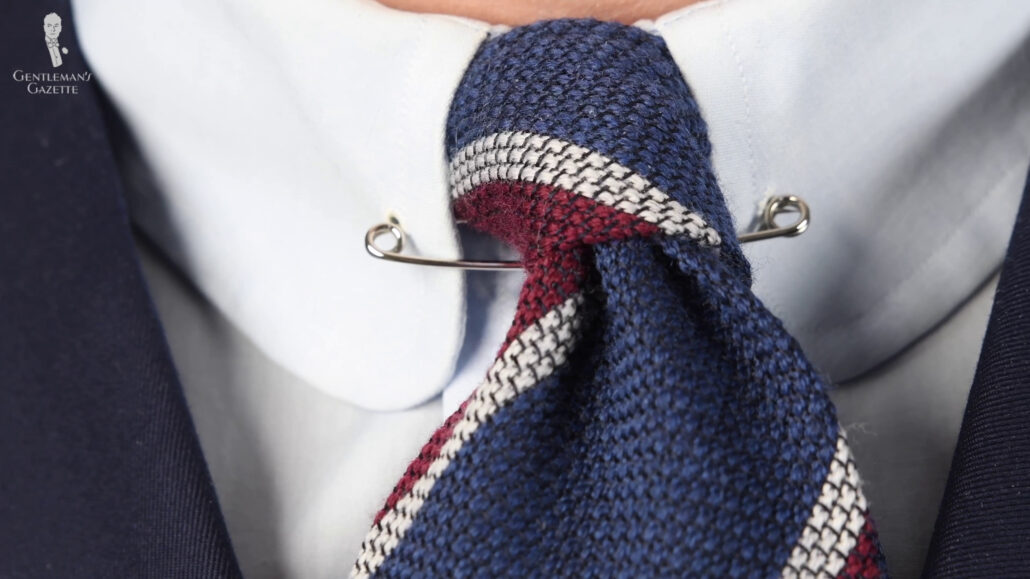
A collar pin is a simple-to-use, understated accessory that works best when it isn’t drawing too much attention to itself. Most collar pins close with a mechanism similar to a large safety pin. Some do feature precious stones or engraved patterns, but oftentimes, these bulkier designs will negatively affect the functionality of the collar pin. This could cause the tie knot to appear to pop out more than desired or cause the collar leaves to appear distended. More scaled-down collar pins then will appear just as elegant with none of these drawbacks.
Which Collars Are Best for a Collar Pin?
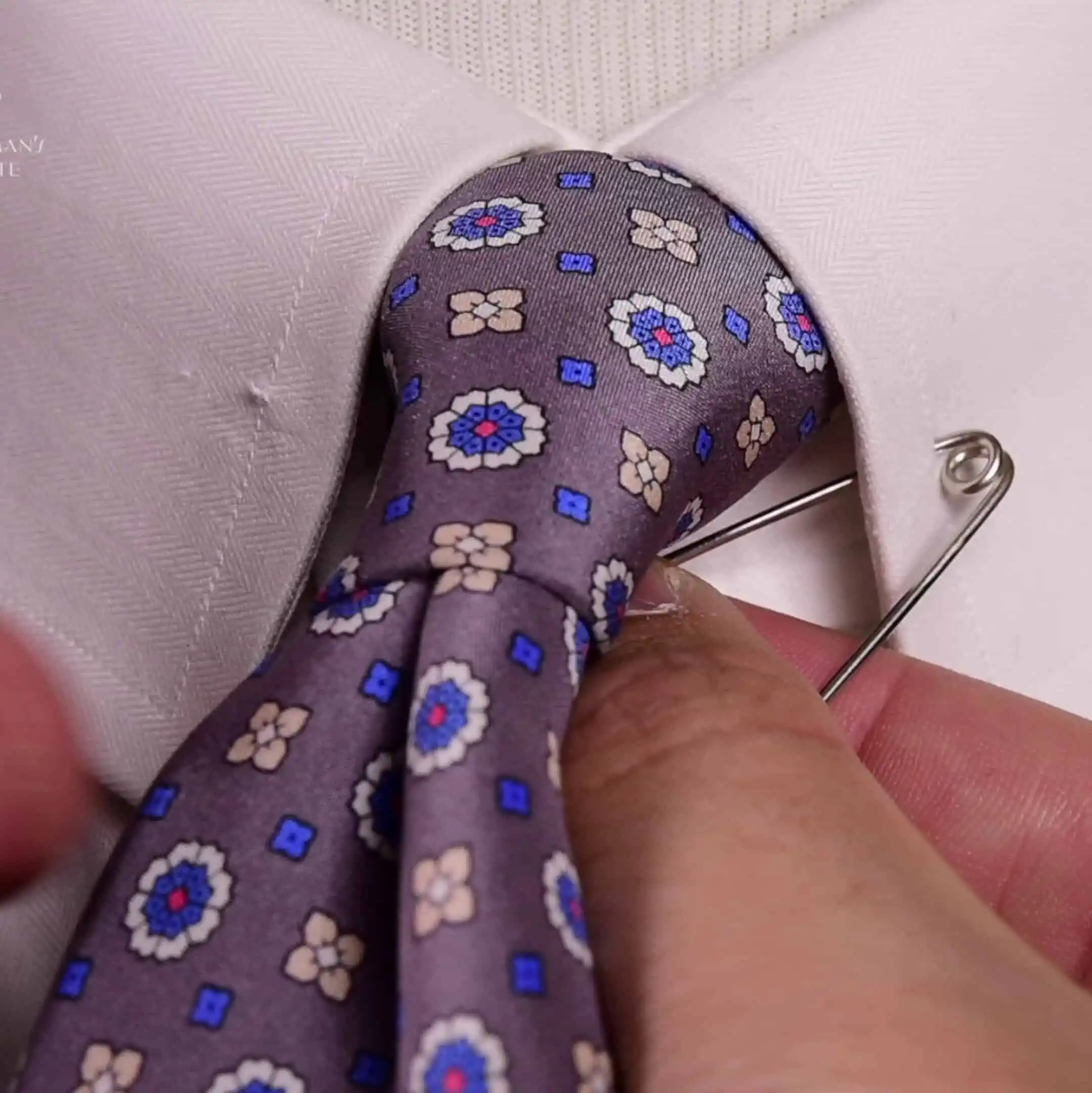
Collar pins are designed to be worn with soft, turned-down collars that are unstructured. The pin is able to draw the collar leaves together nicely for a tidy and trim appearance. Of course, the pin needs to be able to reach both of the collar leaves, so collar pins – and most collar jewelry, for that matter – aren’t really designed to be worn with widespread or cutaway collars. Obviously, because collar pins work by poking into the fabric, they do require piercing your shirt collar.
For fused collars – in which the collar interlining is heated and glued together, and the appearance of the collar is stiff, shiny, and relatively inflexible – these holes can be fairly noticeable because the material is broken by the pinpoint.
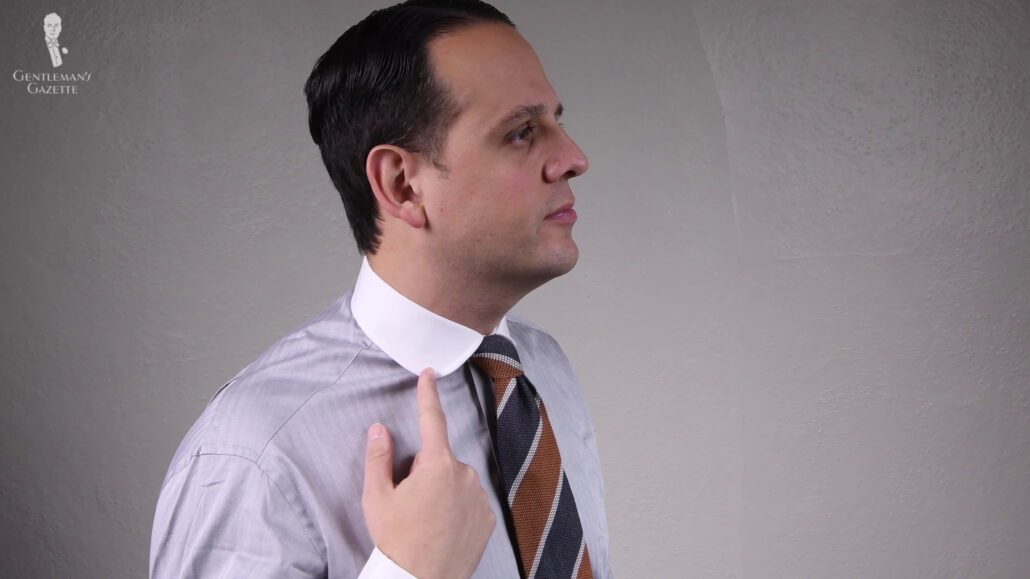
To avoid these noticeable holes then, reserve your collar pins for unfused collars, which you can distinguish by their soft, unstructured appearance.
Here, the pinpoint is more likely to push its way between the fabric’s fibers as opposed to directly through them. Damage to the shirt collar material can also be eliminated or at least mitigated by the use of extremely narrow pinpoints.
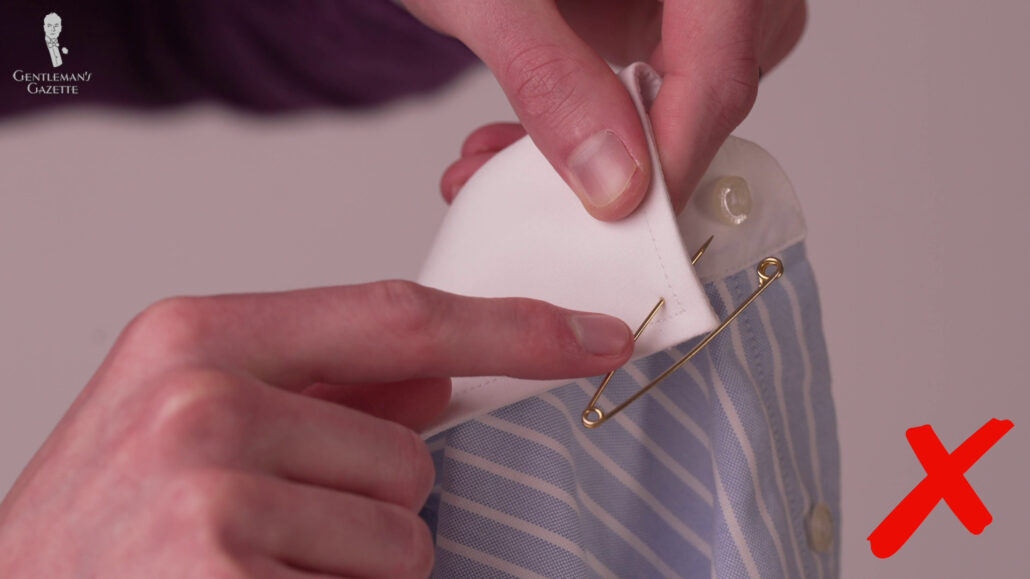
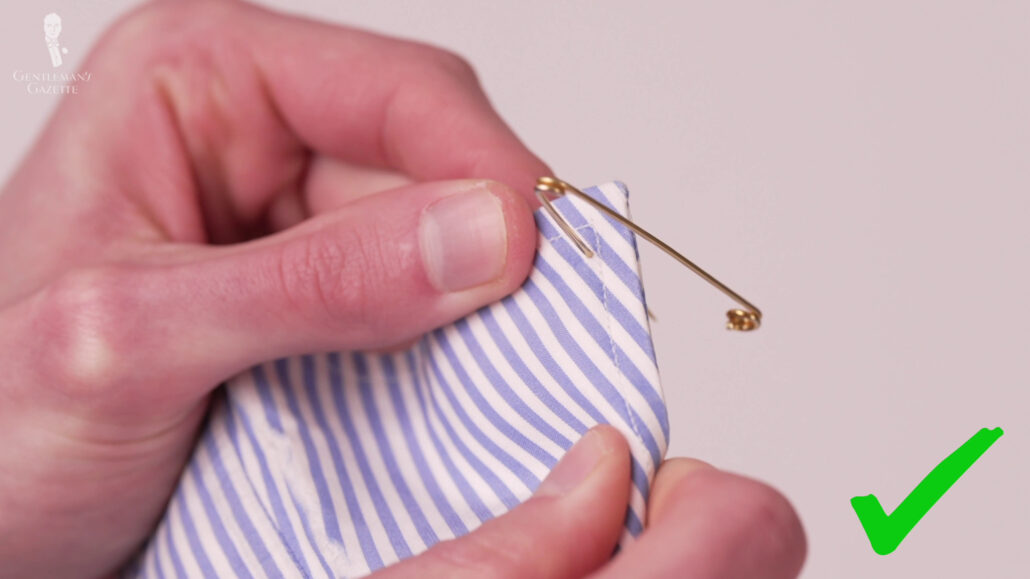
When designing our Fort Belvedere collar pins, for example, we intentionally made our pinpoints 25% slimmer than the market average, so you can use them with multiple types of shirt collars without poking them full of holes.
And if you’re highly concerned about collar damage, you can also wear your collar pins with a type of collar that comes with holes pre-made, but for more on this, we’ll get into our next type of collar jewelry: the collar bar.
6. Collar Bars
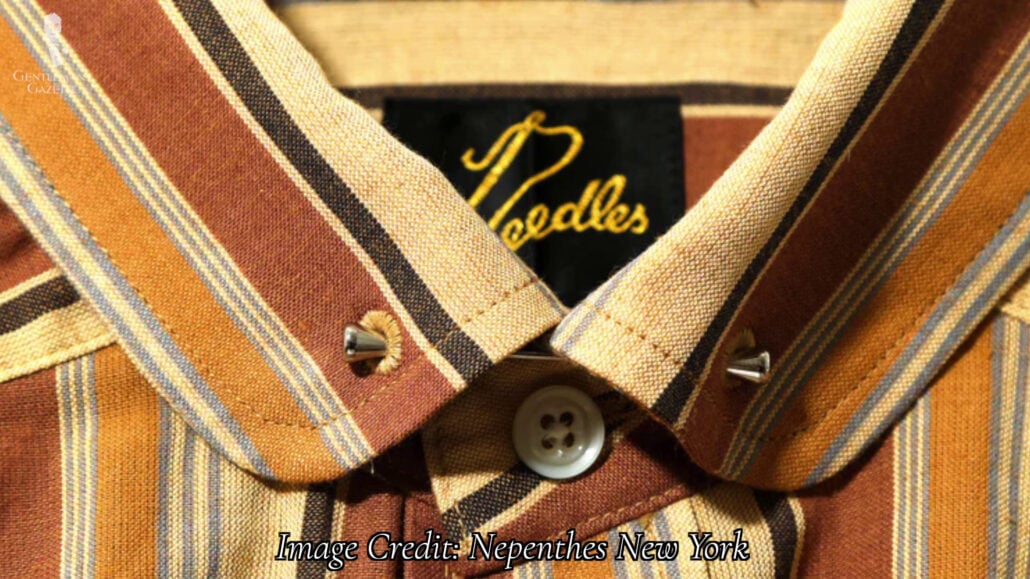
Of course, you won’t need to poke any holes in your collar if they already come pre-poked. Shirt collars, known as “pinhole collars” come with pre-finished eyelets in them. And while they can be worn with collar pins, they’re ideally designed for collar bars.
This type of collar jewelry consists of a bar that runs from one collar leaf to the other, passing through the eyelets, and which is secured at either end by a guard. Collar bars are definitely a statement piece as they require a specific type of shirt collar, and they draw more attention because of their guards.
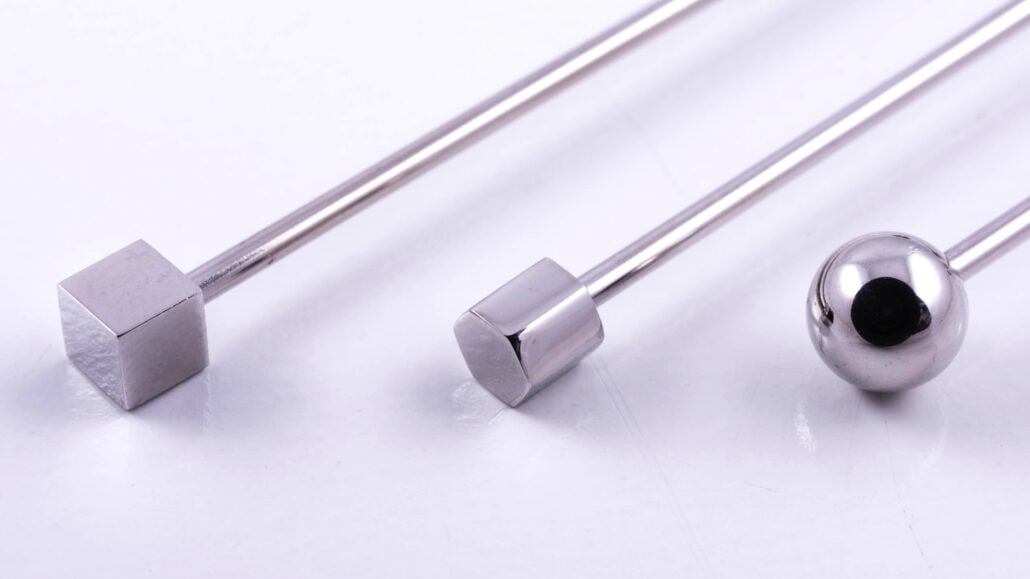
The simplest guards are dumbbell or barbell shaped with a spherical design, but more ornate designs are also available with things like art deco-inspired cubes and hexagons that are definitely indicative of the classic style.
While other guard shapes, more use of color, and elements like decorative chains are more common in modern designs, we would again generally recommend shying away from these if what you’re going for is a classic look.
Which Collars Are Best for a Collar Bar?
When it comes to which collars are best here, as we already stated, you pretty much have to wear a collar bar with a collar that has its pinholes pre-made. And no, we wouldn’t suggest that you try making your own.
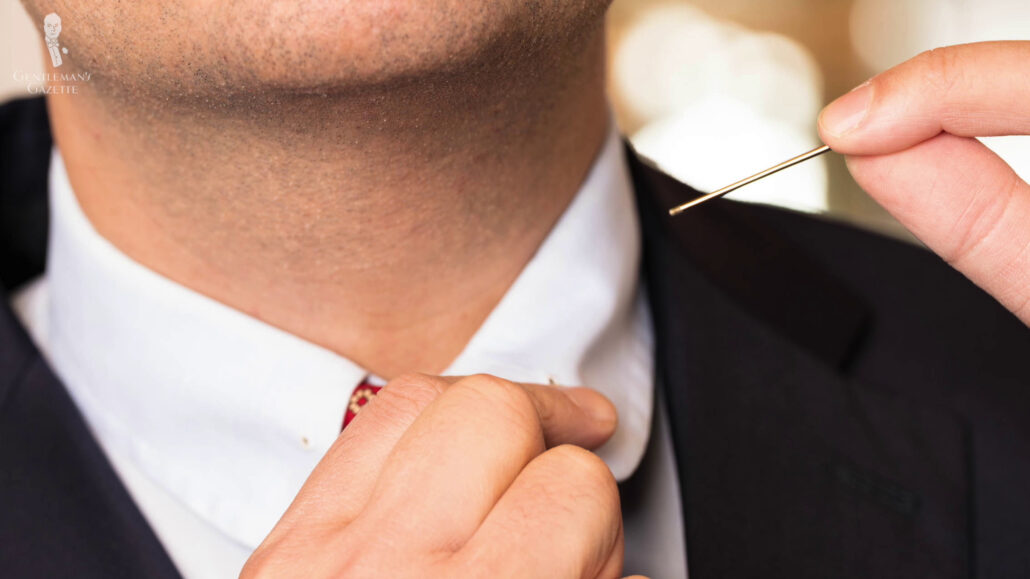
Note also that collar bars do have a set length, so it’s important that you harmonize the length of the bar with the spread of your collar. The end guards should be flush with the eyelets. So, if the spread is too narrow, things are going to look bunched, and, if it’s too wide, you’ll have awkward gaps at either side.
In the past, men attempted to solve this issue with adjustable, over-engineered collar bars, but a simpler and better solution is just to buy a collar bar that is in the proper size, which is why we at Fort Belvedere offer our collar bars in three sizes.
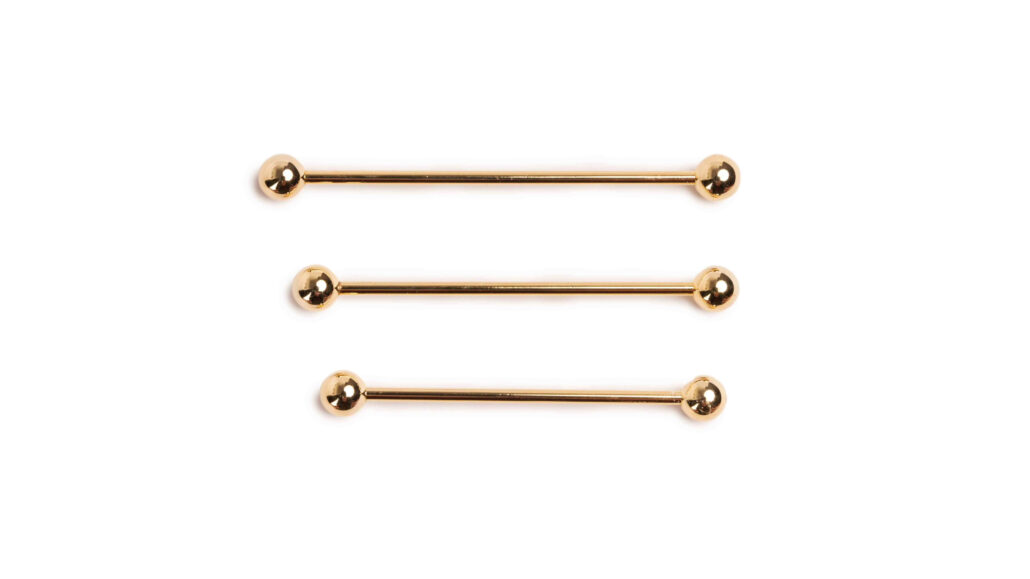
7. Collar Clips
Now that we’ve covered collar jewelry with particular requirements like special shirt collars or fabrics that can avoid damage. Let’s close our list with the most accessible form of color jewelry out there: the collar clip.
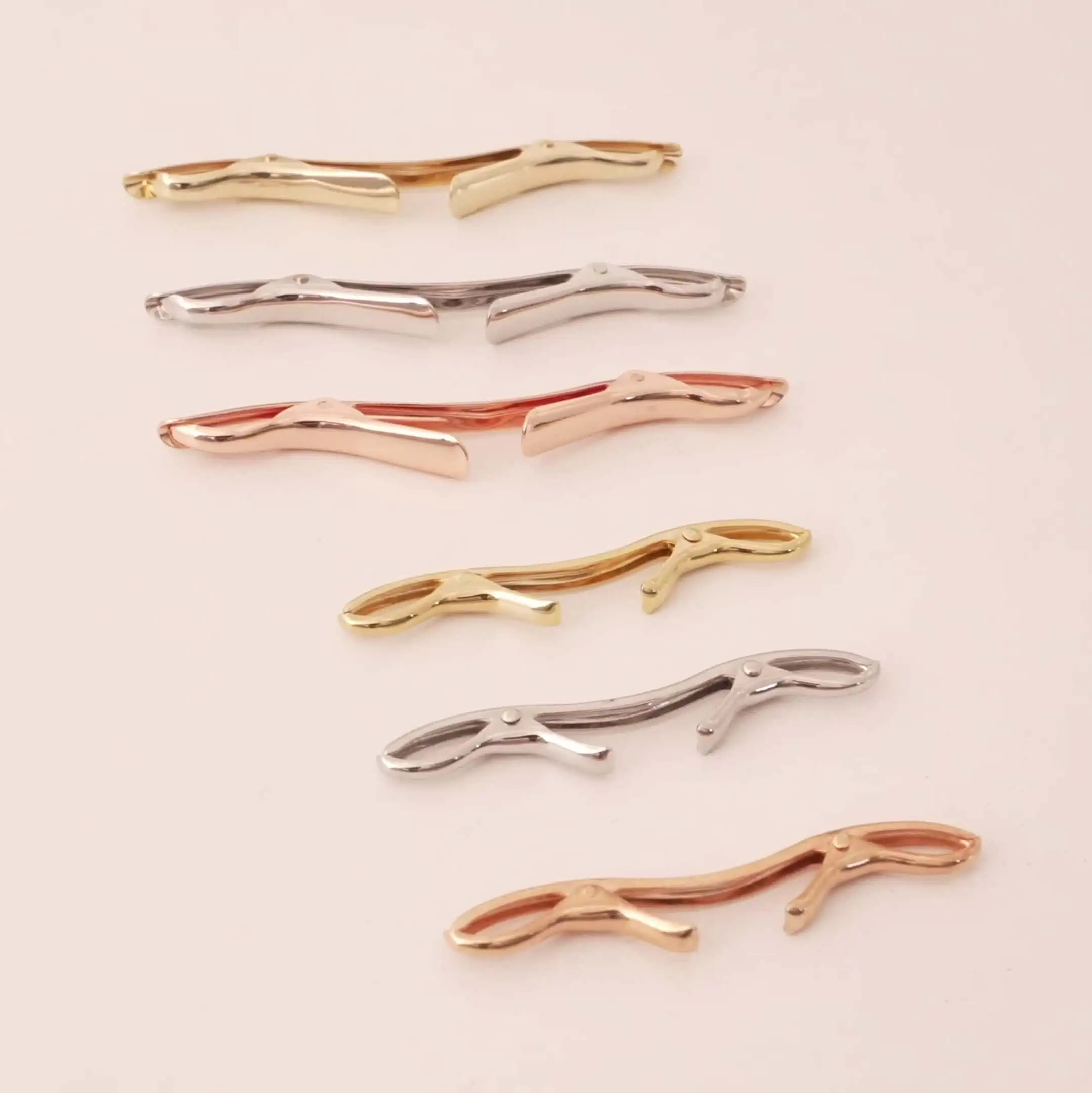
Developed in the 1920s, the collar clip – also sometimes called a “collar grip” – simply clips on to each leaf of your collar. They have slightly more bulk and, therefore, more visual interest than a collar pin with a strong horizontal line that’s reminiscent of a collar bar. Some clips work by sliding them over the leaves of the collar, where they’re then held in place with tension from the bifurcated, sprung metal.
This style was pioneered by the Swank Company, so you’ll sometimes hear them referred to as “Swank clips.” Because only tension is holding them in place, however, they can come loose if you’re moving your head and neck to a greater degree and are more likely to do so as the clip ages or is used over time.
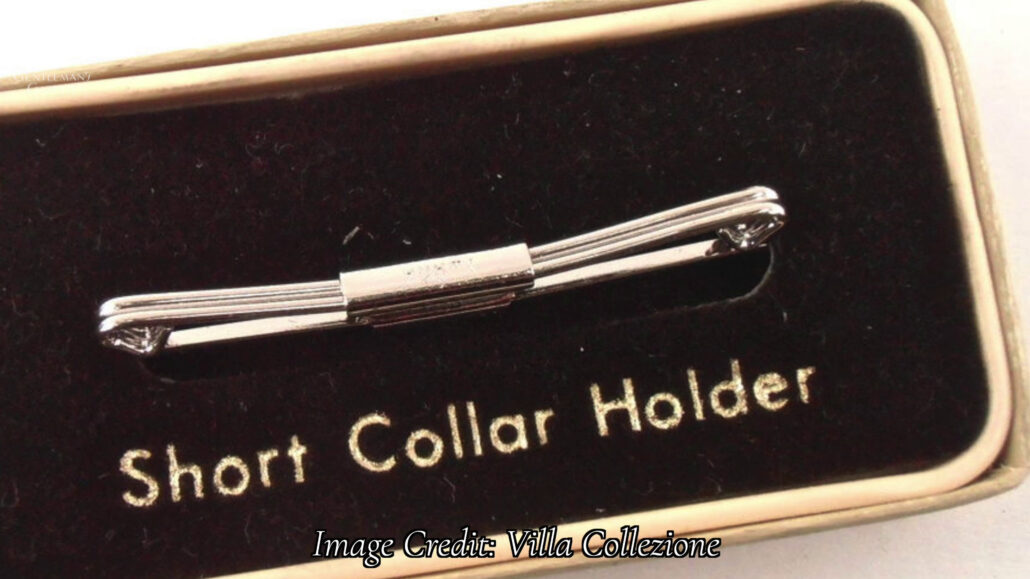
Other mechanisms use levers that reveal a dull pin or tooth. When the lever is snapped back over the leaf of the collar, the tooth holds it firmly in place. Perhaps the best mechanism though is one popularized in the early-20th century that uses simple sprung clips. These won’t damage your collar, are easy to apply, and stay on reliably.
This type of design is the one that inspired our Fort Belvedere collar clips, although we’ve made some further improvements.
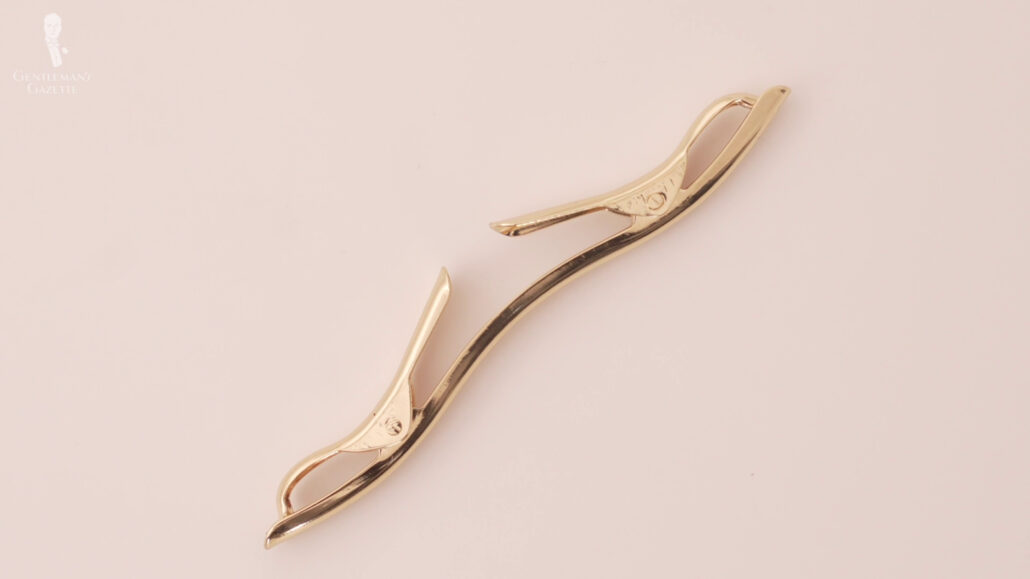
Our collar clip is more ergonomic with its concave middle, giving your tie a place to sit, creating a perfect harmony between tie knot, collar, and clip. We’ve also engineered our clips with tighter coils than other brands, ensuring that they won’t slip, giving you a good grip without damaging your collar.
Which Collars Are Best for a Collar Clip?
Collar clips work well with just about any type of standard, turned-down collar, fused or unfused, provided that the clip can actually reach both leaves of the collar comfortably. We wouldn’t recommend wearing them with pinhole collars, though, as this combination would be unnecessary and would look a little silly. Don’t wear them with button-down collars or tab collars either. as this would again be redundant.
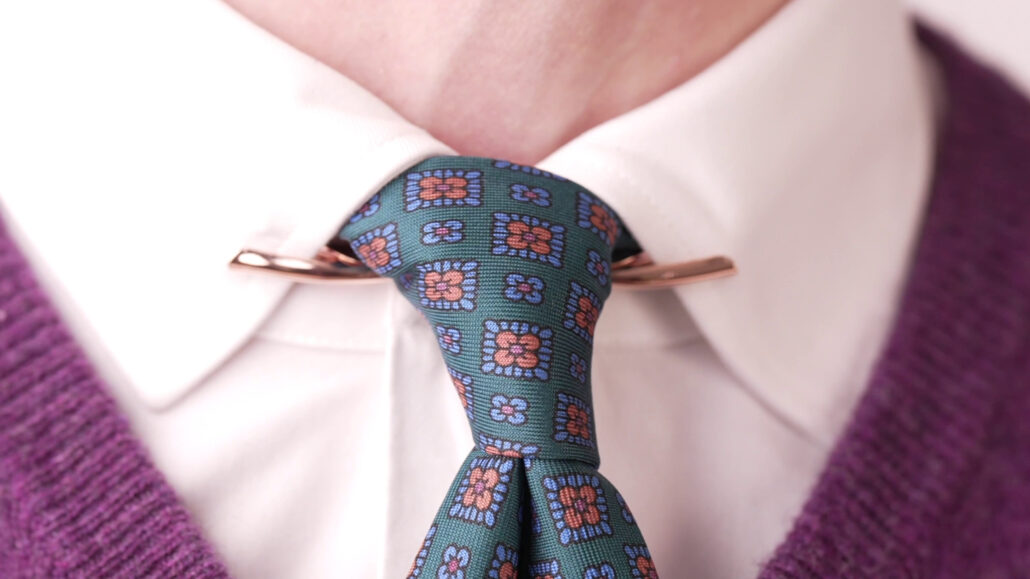
And by the way, if you’d like to learn more about niche collar types, you can consult our guide on collars.
Shirt Collar Styles for Men: The Complete Guide
You want the clip to sit elegantly and unobtrusively. Although, its exact appearance will vary based on whether you are wearing a collar with a narrower or wider spread. A clip length of about 50 millimeters or two inches is best for standard collars, or those with an even narrower spread. Meanwhile, a clip length of 70 millimeters or about two and three-quarters inches is best for wider-spread collars or men with thicker necks, who therefore need larger collars. And whichever of these you need, you’re in luck, as Fort Belvedere offers collar clips in both lengths.
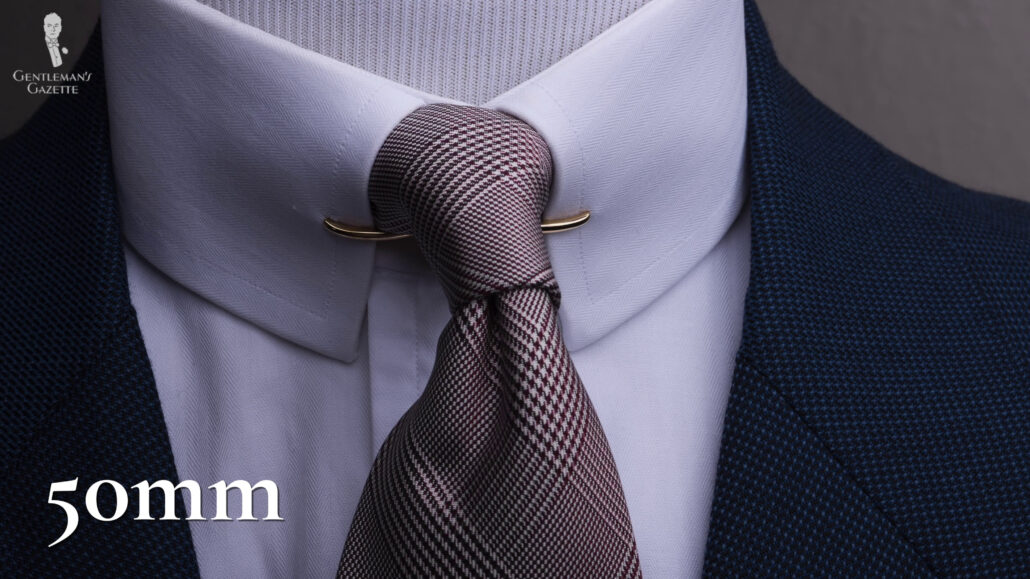
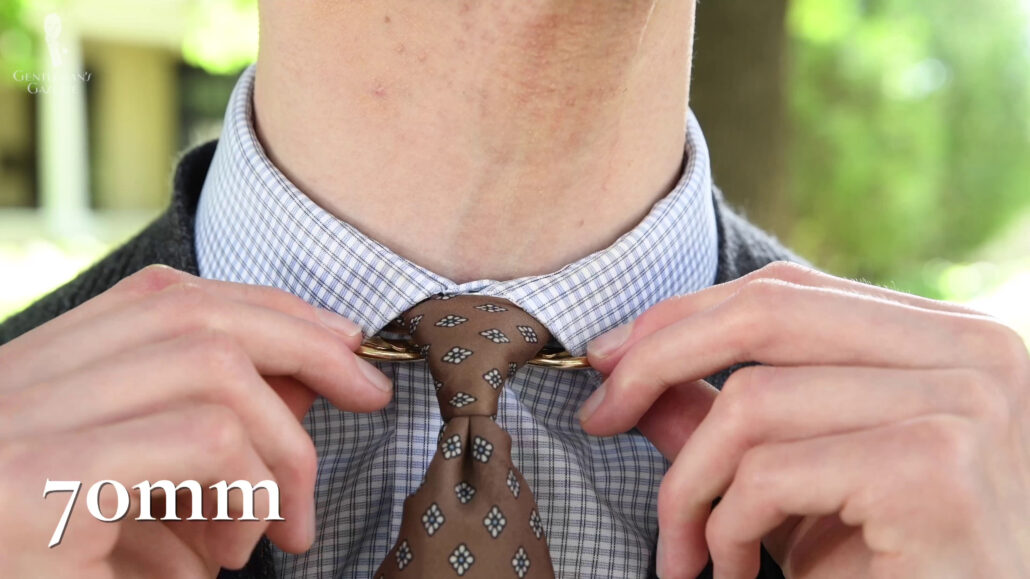
Our classic 50-millimeter clips have been a favorite among our customers for years and our large 70-millimeter clips are now stronger and sturdier than ever before. And both lengths are available in yellow gold, rose gold, and platinum silver finishes.
Construction and Materials
On that note, let’s briefly transition from talking about collar jewelry types to discussing construction and materials. The specific functionality of each type of collar jewelry dictates how it’s assembled, but the most important aspect across all types is the material from which the jewelry is made.
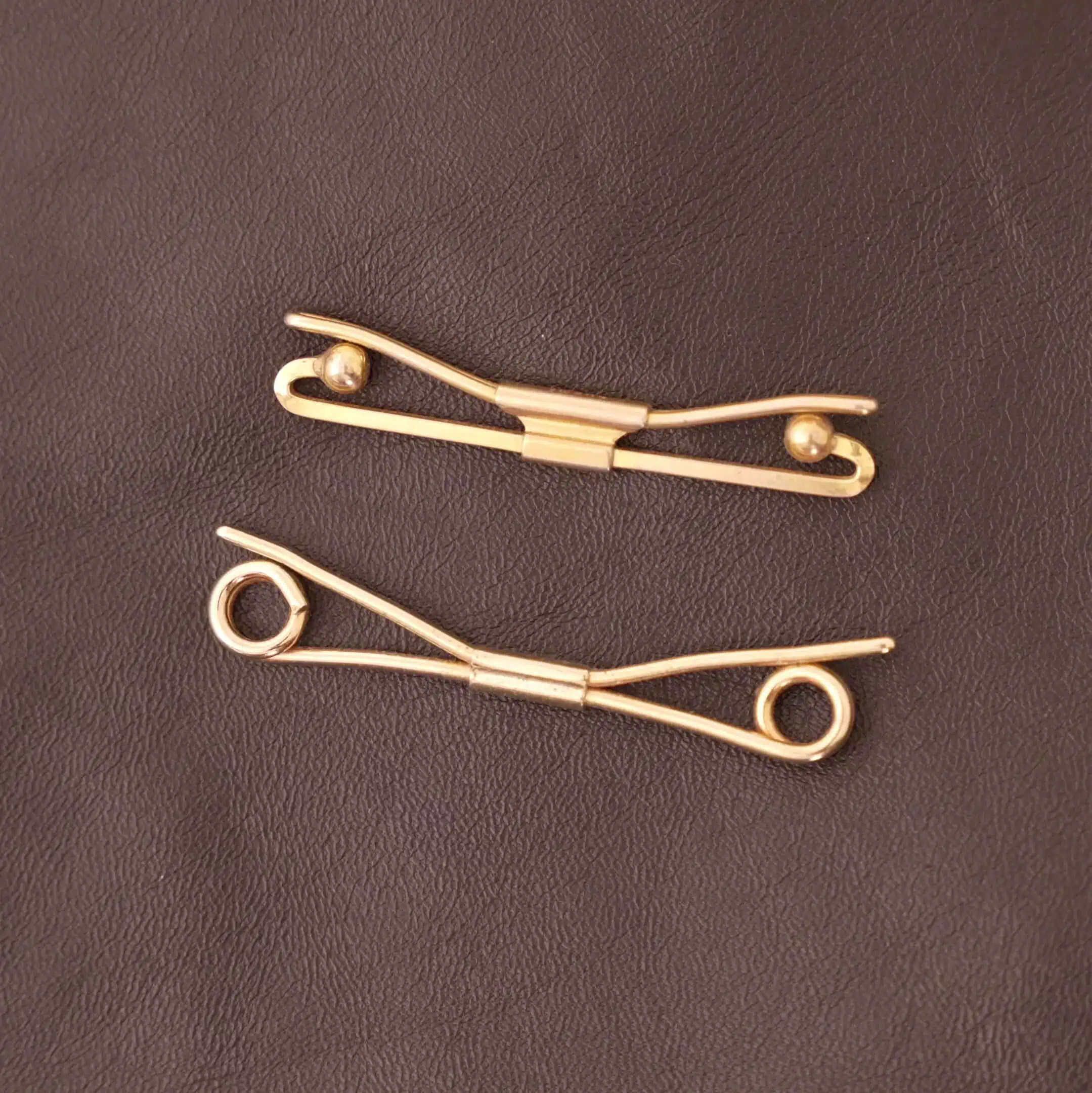
The most favored materials for collar jewelry are those that have gold or silver lusters. These include base metals in similar tones, base metals plated in precious metals, or solid precious metals. Pure base metals are inexpensive and durable in and of themselves. But, to keep prices low, they’re often poorly constructed, leading to a flimsy final product. And, of course, they lack the genuine, rich luster of precious metals.
On the other hand, solid precious metals have a gorgeous appearance, but they’re often very expensive. As an example, the raw metal for a solid gold collar clip weighing just 8 grams would cost over four hundred dollars. Also, precious metals are very soft, which isn’t ideal for a hard-wearing, regular-use item like collar jewelry, and this is especially true for a collar clip with its moving parts.
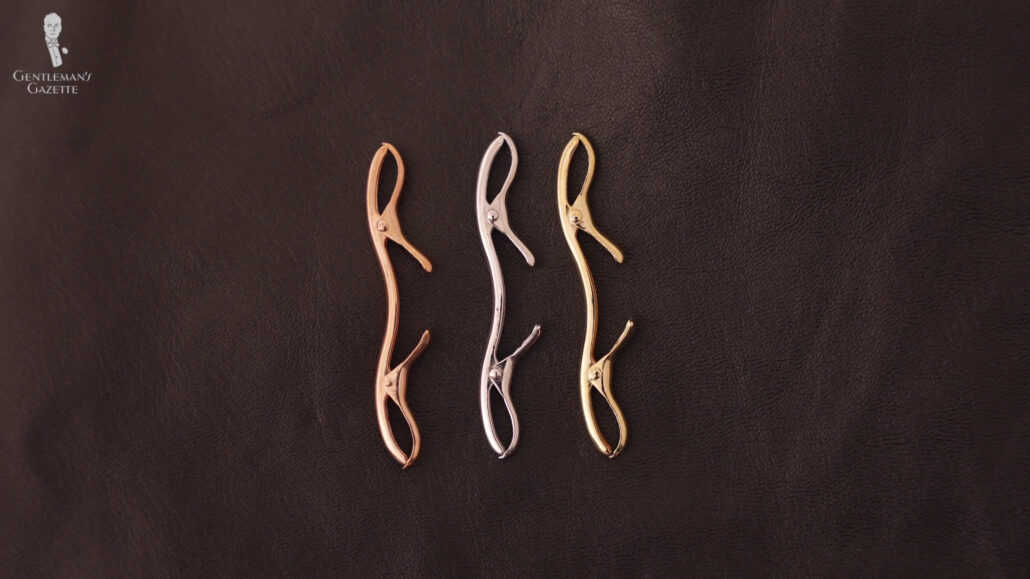
So, then, plating can give you the best of both worlds with the lustrous appearance of precious metals and the durability of base metals, all at a reasonable cost. As an example, at Fort Belvedere, our collar jewelry is made from solid brass or stainless steel, ensuring durability and a pleasant heft, and it’s then plated with one of three precious metals – brilliant yellow gold, warm rose gold, or alluring silver platinum.
Also, we at Fort Belvedere use an extra thick plating layer of two microns. So, you’ll never have to worry about the precious metals rubbing off, even with repeated use.
Tips For Wearing
Finally, today, now that we’ve learned about the different types of collar jewelry and how they’re made. Let’s discuss how you can wear them stylishly.
1. Not Above the Knot
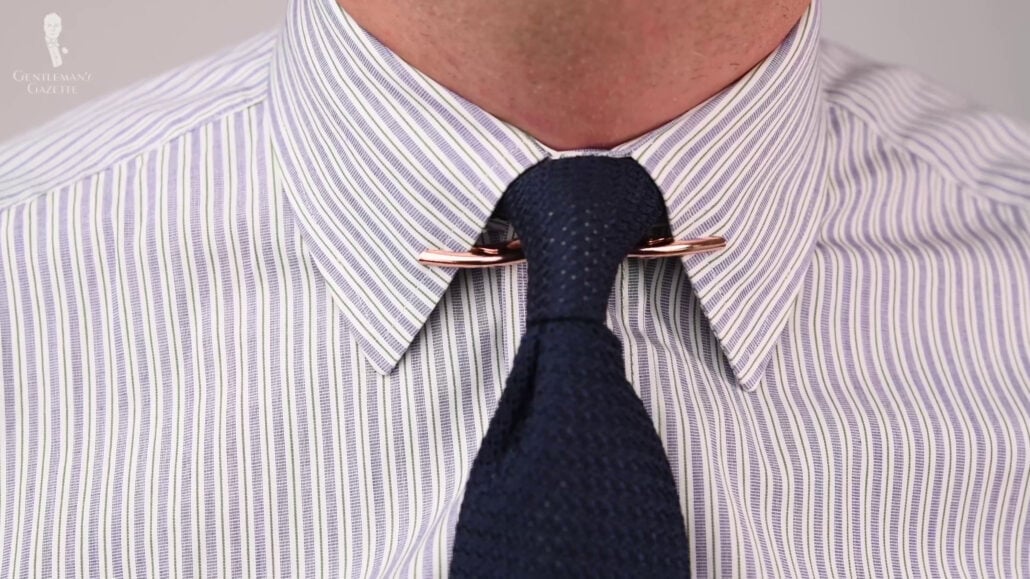
Collar jewelry should be worn underneath your tie knot to delicately elevate it and put on after you’ve tied your tie. Also, for a classic look, collar jewelry shouldn’t be worn with a conventional long necktie as opposed to by itself. And by the way, don’t wear a bow tie either as it would cover up the jewelry and defeat the purpose.
2. Know Your Knot
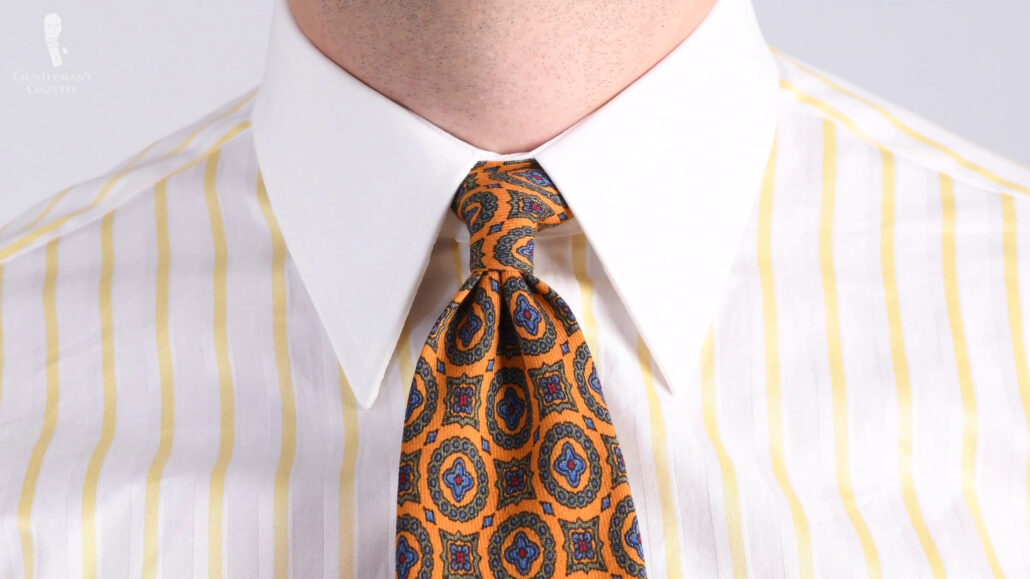
To avoid bulging out, collar jewelry usually looks best when worn with slimmer tie knots like the Four-in-Hand or the Oriental. By the way, you can learn how to tie both of those knots here.
3. Suitably Sized
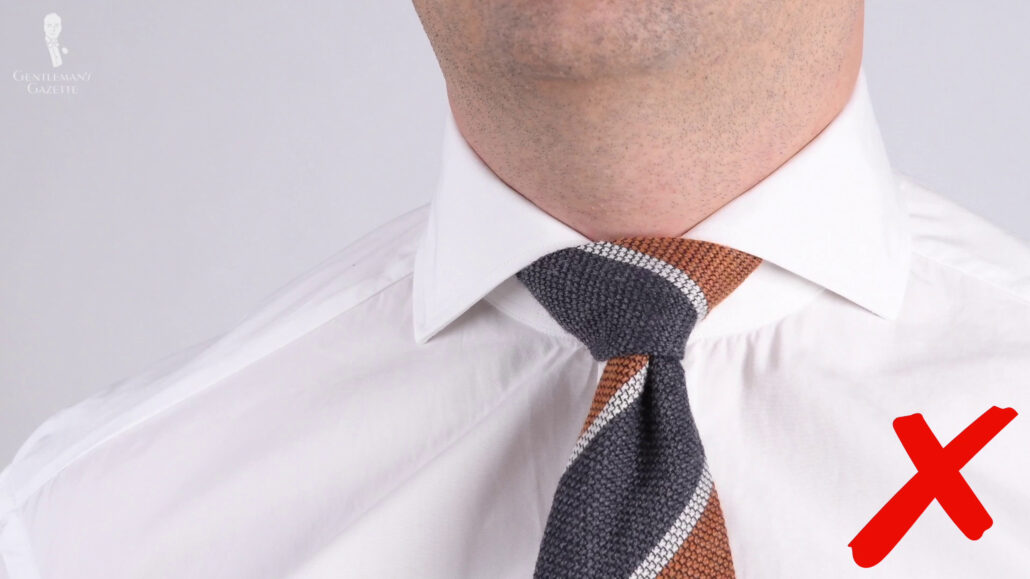
As we’ve mentioned several times today, properly-sized collar jewelry is essential for a dapper look. If the jewelry is too small, it will pinch and wrinkle your collar and, if it’s too large, it will hang down or extend too far out. And, of course, neither of these are a good look. Know also that collar jewelry shouldn’t really be worn at all with extremely widespread or cutaway collars, wing collars, or any of the other semi-obscure collar types we alluded to previously.
4. Less is More
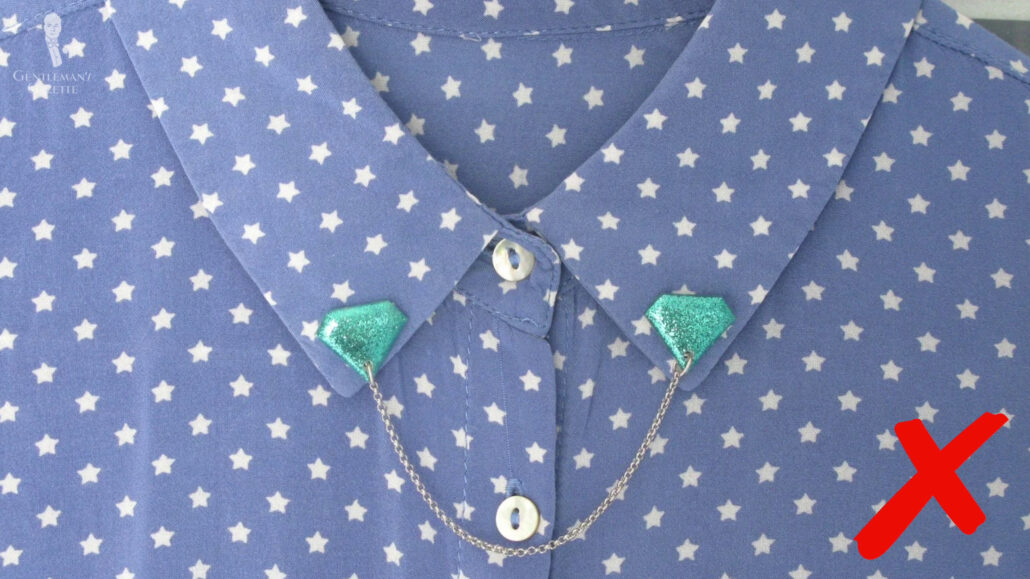
Showy or flashy elements like precious stones, carvings, chains, and the like are all going to draw all of your onlookers’ attention directly to your collar jewelry. Classically though, collar jewelry is meant to delicately structure your collar and elevate your tie knot, all in an understated way. Therefore, we’d suggest that you opt for simple, timeless designs that help to complete your look and make everything shine harmoniously.
5. Formulate Formality
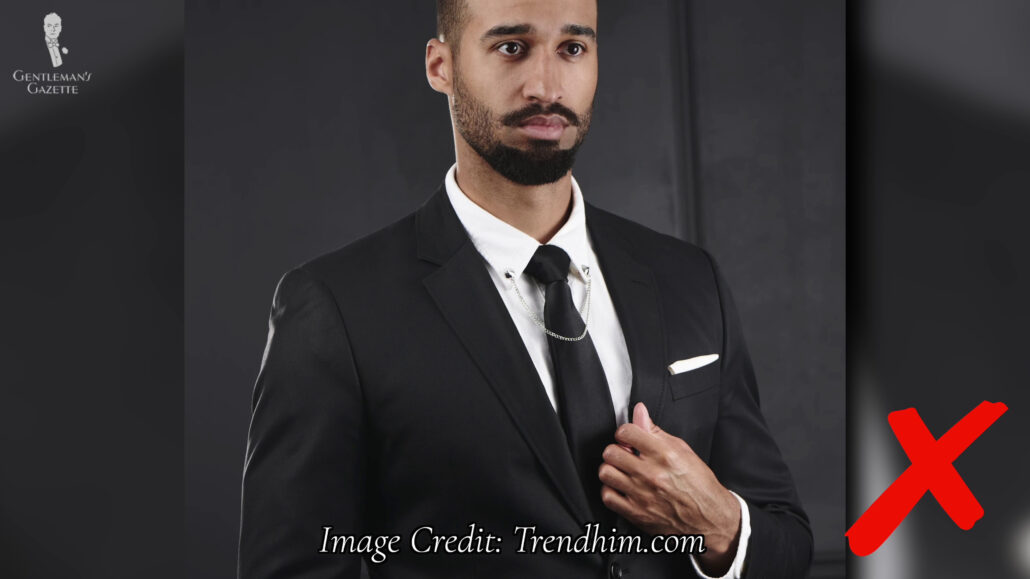
Despite its current popularity in some arenas of more contemporary formal styling, collar jewelry – classically speaking – shouldn’t be worn with Black Tie-optional attire and certainly not with Black Tie or White Tie.
You can find more information about these most formal dress codes using our comprehensive guides to Black Tie and White Tie. And if you’re interested in more styling tips on how to wear men’s jewelry, we’ve got an entire post on that subject.
Men’s Jewelry: All About Rings, Chains, & More Accessories
Conclusion
So, now that you’ve collared all there is to know about collar jewelry, we can’t wait to see what kinds of looks you put together with this unique menswear accessory type. And to help you get started, we’ll mention that, in our Fort Belvedere shop, we offer bulk discounts. So, with reduced prices, when you buy our collar jewelry pieces in multiples of four, it’s easy to build up a stylish collection quickly.
Outfit Rundown
Today, I am, of course, wearing a piece of collar jewelry. In this case, it is the newest addition to the Fort Belvedere shop, the collar clip in the new, longer length. Made from solid brass and coated in silver-colored platinum, its 70-millimeter length is ideal for the wider-spread collar shirt that I’m wearing.
With that said, though, most of the shirts in my own collection feature classic collars with a narrower spread. So, I typically opt for our classic collar clip in a narrower length. Aside from its spread collar, my shirt doesn’t have too many other details to it. It is, of course, in plain white and simply features barrel cuffs.
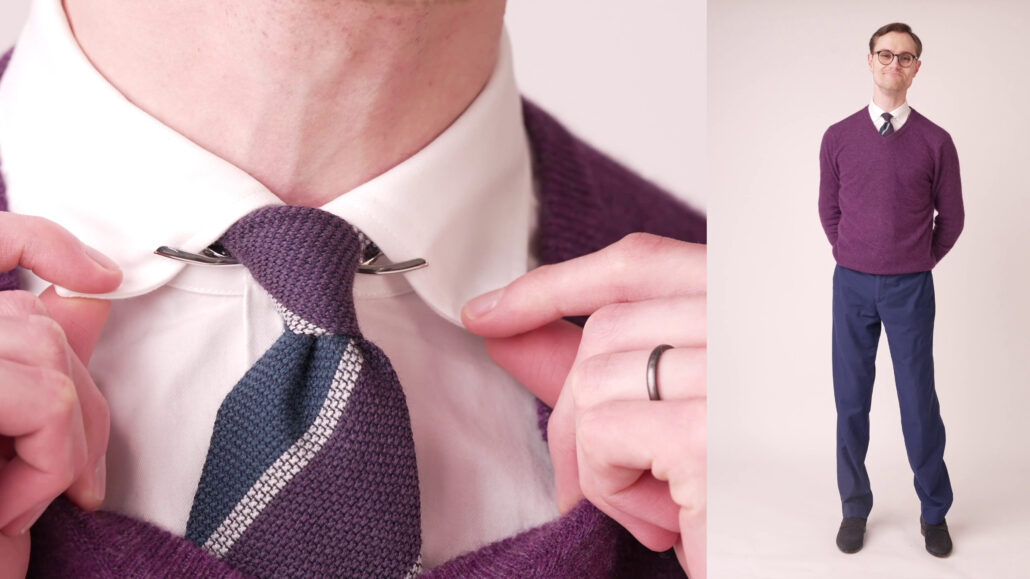
My tie is also from Fort Belvedere today. It’s a blend of cashmere and wool in a grenadine weave, featuring large stripes in petrol blue and purple and a smaller stripe in gray. Working with the colors in the tie, I’ve gone for a V-necked sweater in berry-colored purple cashmere today, and trousers in plain medium blue.
My blue suede shoes are loafers from Henry Stevens, a relatively new line from the German brand, ShoePassion. Finally here, my socks are also from Fort Belvedere. They’re in navy blue, featuring clock patterns in medium blue and white.
To go with the relatively casual feel of the outfit, I’ve left the product out of my hair and let my facial hair grow a bit. And if I were to opt for a fragrance, something like Polo Ralph Lauren’s “Blue” could go with the blue tones in my outfit.
And, of course, you can find all of the Fort Belvedere accessories I’m wearing in today, as well as a wide array of other men’s accessories and collar jewelry in particular, by visiting the Fort Belvedere shop.
